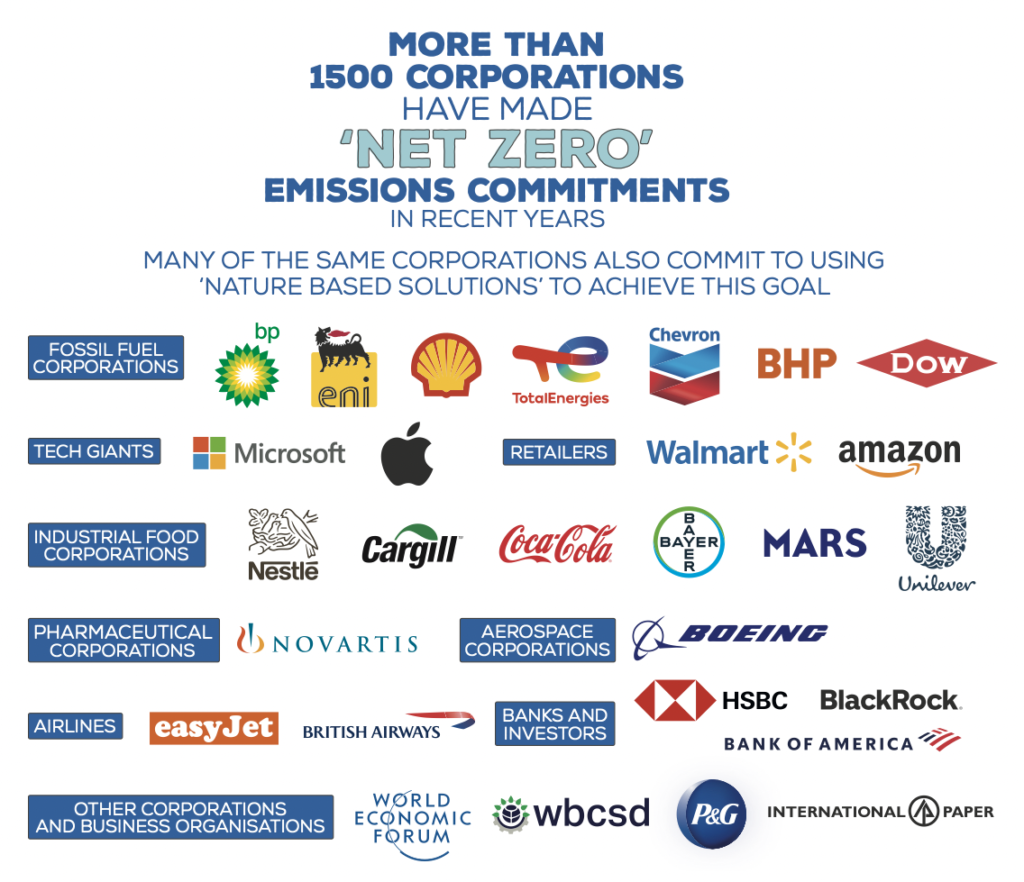Instead of providing real solutions to the climate and biodiversity crisis, net zero pledges and carbon removals divert attention from real action and have negative effects on ecosystems, food security and people’s rights. Michael Staniszewski explains why we have to end fossil fuels and protect nature instead of “planting trees” for business as usual.

Michael Staniszewski is a Fridays for Future (FFF) climate justice activist from Germany. He is part of the movement’s #NotMyTaxonomy campaign and actions.
The climate and biodiversity crises are interconnected
We need to understand that we cannot solve one without the other.
Now businesses have found a way to link them in a way that does not serve either. They pretend they will stop harming the climate and help bring back nature, but are bound to fail on both accounts.
Scientists trying to model a world in which our lives and economic system remain mostly unchanged yet produce no greenhouse gas emissions have found that some sectors will face real problems. They say not only must we do as much as we can to reduce emissions, but we must also absorb and store emissions to get to net zero. For the latter, nature is key. Peatlands, forests or seagrass beds – they are all so-called ‘carbon sinks’ (which naturally absorb carbon) and are crucial in the fight against the climate crisis.
But, there is a problem. Global corporations have been more than happy to go down the net zero route. From fossil fuel giants, like TotalEnergies, Shell and BP, to multi-million dollar corporations, like British Airways, Coca Cola and Nestlé, a large number of businesses are making net zero emission commitments. Doesn’t sound sketchy at all, right?

These corporations won’t be drastically changing their business model. Instead, they reckon that they can continue to cause more emissions and have them “offset” by others.
Their pledges divert attention from the need to radically reduce their emissions. And they also “make the politics, violence, social and ecological destruction of fossil fuel burning and industrial farming invisible”, say Friends of the Earth.
The companies want to look good without doing good. They want to continue hurting the climate whilst telling us that they don’t.
The ‘carbon offset credits’ these companies rely on can be generated in two ways. They either come from projects that aim to “prevent, avoid or reduce emissions”, or from projects that aim to remove CO2 from the atmosphere. So far, most projects fall under the category of ‘avoided emissions’, such as ‘avoided deforestation’. It’s simple – a forest that could be cut down will not be cut down, or so project developers claim. And somehow this counts as saving carbon emissions! What’s more, the carbon savings from such projects are usually exaggerated.
Carbon Offsets: Last Week Tonight with John Oliver (HBO).
A few years ago, the UN Environment Programme (UNEP) was already stating that “carbon offsets have been used by polluters as a free pass for inaction”, adding that such offsets “risk giving the dangerous illusion of a ‘fix’ that will allow our billowing emissions to just continue to grow”.
Environmental NGOs, like Greenpeace, have called carbon offsets a “scam”, demanding #realzero instead. Greenpeace has made it clear that we need to reduce emissions and protect nature to prevent a climate breakdown – and they are right. There is no time for offsets!
Now, the European Commission has released the so-called Carbon Removals Certification framework, which has been harshly criticised by the European Environmental Bureau (EEB) as a proposal that “falls woefully short of what is needed”. They’ve called the proposal a “framework to certify greenwashing.”
Today, more and more offset projects are based on the premise that they will “remove emissions”. Conservation organisations like The Nature Conservancy partner with corporations like Shell, Cargill and Syngenta to develop such “nature-based solutions”.
The finance industry sees “nature-based solutions” as a huge opportunity. It estimates the potential market value to be 3.3 trillion dollars, seeing “enormous new opportunities for both project developers and investors”.
Don’t get me wrong. We need to preserve and restore ecosystems where possible. Healthy ecosystems that function as carbon sinks like peatlands, tidal flats or seagrass beds are essential for a stable climate on this planet. But the way “nature-based” carbon removals work currently could have massive negative effects on ecosystems, food security and people’s rights.
Most projected “nature-based” carbon removals, promoted by The Nature Conservancy and others, are supposed to come from reforestation, mainly in the Global South.
That sounds like an attractive proposition. Everybody loves trees. Donald Trump wants to plant a trillion trees. The EU only wants 3 billion (and has achieved 1% of that). And I guess Elon Musk wants to plant trees on Mars…
But, it is not that simple. A forest is a highly complex and interlinked ecosystem. It consists of a broad community of organisms like various kinds of fungi, lichen, shrubs, insects, mammals and even specific bacteria, which are actually responsible for that familiar earthy forest smell. It takes decades and specific environmental conditions for these exact conditions to establish. Only this way can a forest function in a holistic way and become a proper carbon sink.
With climate change, environmental conditions become unpredictable. Areas that have favourable conditions for a certain species today might not have them anymore in 10 to 20 years. There is no guarantee that a newly planted tree will survive.
A recent study has found that about half of the planted trees in tropical and sub-tropical forest restoration efforts did not survive more than five years. The researchers concluded that “planting for restoration is potentially rewarding but risky and context-dependent.”
But it gets worse. In most cases, tree planting will create a plantation made up of a single tree species – not forests. The UN says that almost half of reforested areas around the world are monocultures used to produce wood.
A forest is not just trees. Whilst natural forests have high levels of biodiversity and a large ability to absorb and store carbon, plantations do not have that. You can only plant trees, not forests. The word reforestation is misleading, as its outcome is not necessarily a forest.
Planting trees can even have adverse effects. Invasive species, like the eucalyptus tree, have been introduced throughout the world and are outcompeting native species. Eucalyptus reduces the water available to other plants as its roots grow very deep, lowering the groundwater level. This has a negative effect on the ecosystem composition, leading to lower biodiversity.
Yet, this is exactly what is happening in Brazil where Suzano, a pulp and paper company, plants fast-growing eucalyptus to increase wood yields and claims its operations remove carbon from the atmosphere. The company has even applied for – and received – a licence to plant genetically modified eucalyptus trees that are resistant to the herbicide glyphosate. But these plantations are not forests. From an ecological perspective, they are green deserts without biodiversity.
There is not enough land to offset the carbon we produce
Proponents of “nature-based solutions” say we should reforest no less than 678 million hectares of land, approximately the size of Brazil or Australia.
Where should we plant a million, a billion or even a trillion trees? In your backyard?
Essentially that would not be in the Global North where land is expensive and planting trees would drive prices further up.
Most of these measures would happen in the Global South, in the regions most affected by the climate crisis, putting pressure on the land available. Scientists and environmental NGOs such as Greenpeace and Friends of the Earth International agree that nature-based carbon removals in these areas will exacerbate negative impacts on livelihoods, land rights, food production and ecosystems. This means basically human rights violations, huge land grabs, expansion of large monocultures and biodiversity loss.
Let’s finally protect pristine ecosystems
The priority must be to protect existing, pristine ecosystems. These are most resilient in the face of climate change, show high levels of biodiversity and have large carbon binding as well as storage abilities. This goes for forests and other ecosystems that function as carbon sinks, like peatlands, tidal flats or seagrass beds.
Indigenous and local communities are key to this process. They guard against deforestation and conserve biodiversity while sustainably producing food for their communities. Indigenous land makes up to 20% of the Earth’s territory, but contains around 80% of the remaining biodiversity. Indigenous communities are the guardians of biodiversity, while belonging to the group most affected by the climate crisis.
Cut emissions instead of offsetting them – The system has to change
Instead of greenwashing the climate crisis, we need to address the problem at its root – fossil fuels and the destruction of ecosystems. For real climate action, the historical and current largest emitters have to step up. This includes radically cutting their emissions and providing loss and damage reparations for the most affected people and areas.
We need regulations that effectively end the use of fossil fuels and allow for a socially just transition. This will also prevent further environmental destruction and pollution through open pit mines, fracking for gas or oil spills.
Net zero pledges from companies that want to continue business as usual are not an option. Business as usual means no future!
Carbon offsetting projects overestimate the amount of carbon they save. They are a surefire way for us to miss our hard-fought climate targets. Carbon removal and “nature-based solutions” are greenwashing at its best. Instead of saving us from climate breakdown, they threaten livelihoods, human rights and biodiversity.
For climate justice, we need to rethink the entire capitalist system that is based on the use of fossil fuels and destruction of nature. We need true solutions that put people over profits and protect both our climate and nature at once.